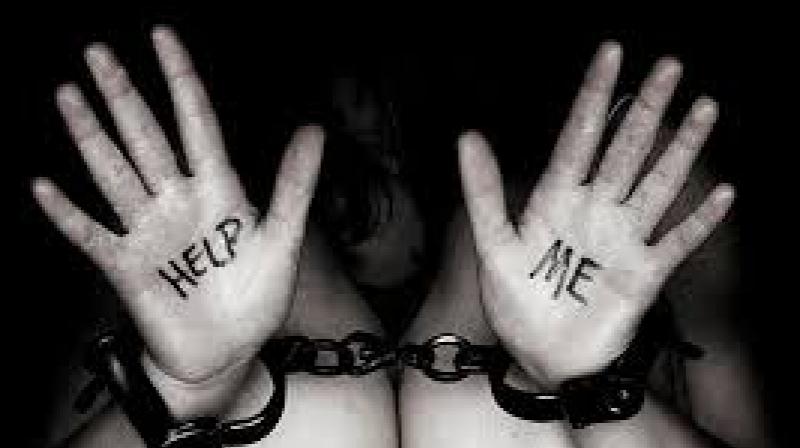System Revamp: Rescue homes jails' of a different kind
Telangana has the fourth highest number of human trafficking cases.

Hyderabad: Soni (name changed) was a victim of trafficking, brought from Delhi to Hyderabad when she was 11 years old. Raped at 14 by a hotel owner in Nampally, where she was employed, the minor was found to be pregnant during the case proceedings. Following a court order, she was shifted to a government rescue home at Yusufguda, where she gave birth to a girl.
Though her medical records stated that Soni was suffering from tuberculosis (TB) and needed treatment, she was deemed 'untouchable' owing to her history of rape, and her care neglected. In the last stages of TB, she was finally sent to a Christian missionary home for treatment, but it was too little, too late. In November 2017, she was found dead in her bed at the home.
Soni's case is not an isolated one. An increasing number of stories like hers highlight the ugly reality of rescue homes, which seem to have become less about rehabilitation and more about forced confinement. Doubts are now being raised whether women and children rescued from flesh trade and trafficking rackets can indeed lead a protected life in these homes.
Take the instance of Pavani (name changed), a sex worker, rescued from Secunderabad railway station and sent to a women and child rescue centre. Tired of being victimised for a contagious disease that she suffered from, she gave home authorities the slip and escaped. Another woman attempted suicide by jumping from the first floor of a rescue home as she was forced into prostitution after being rescued.
Every month, 60-80 women are picked up, mostly from railway stations, brothels, and streets, booked under the Prevention of Immoral Trafficking Act by the police, and sent to rescue homes following court orders.
Sunitha Krishnan, founder of anti-trafficking organisation Prajwala, says, “As far as facilities go, government-run homes only provide boarding and lodging, they don't rehabilitate. Rehabilitation is a sum of three major issues: psycho-social and physical well-being of the victims, which includes trauma care, counselling, and healthcare. Every trafficked girl goes through extensive physical damage, including traumatic brain injuries; second, providing education and economically viable career options, and preparing them for education, helping them find employment; third, a complete restoration of identity, called ‘civic rehabilitation,’which means obtaining government sanctioned means of identification, such as ration cards, and housing.
“These three acts define ‘rehabilitation’, but these are certainly not provided by the homes which house these victims. There is hardly any budget allocation, and no vocational training. There is a huge need for a system revamp.”
Records show that rescued women, including those caught in the commercial sex trade, suffer from sexual and reproductive health complications including sexually transmitted diseases (STD) and other gynaecological problems. Such women face the risk of unwanted pregnancies and miscarriages. Women sex workers also experience high rates of abortion, sterility and infertility. This apart, they are also victims of various kinds of substance abuse, including alcohol, and suffer from withdrawal symptoms which go unaddressed.
Prof. Daisy Bora, director of the Centre for Women's Studies in Assam's Dibrugarh University, says, "The first blow they experience is when they are labelled ‘victims of trafficking,’ and feel a loss of freedom.
The excruciating case proceedings and being constantly exposed take their toll, damaging their mental state, and many slip into depression, leading to suicidal tendencies. Second, when rescued women require medical assistance but are denied or neglected, they die even before their actual death. They give in to sickness because they have no hope or help. They see no reason to live as their social image is so badly damaged.”
“Victims undergo feelings of severe guilt, post-traumatic stress disorder, depression, anxiety, substance abuse (alcohol or drugs) and eating disorders. In extreme cases, mental anguish can lead to self-mutilation or suicide. Victims of trafficking often need psychological care as part of standard medical treatment,” adds consultant psychiatrist Purnima Nagaraja.
According to the National Crime Records Bureau, Telangana has the fourth highest number of human trafficking cases, after Tamil Nadu, Assam and West Bengal, with a share of 8.2 per cent.
A large number of the girls and women trafficked to Hyderabad and other parts of Telangana are from West Bengal and Assam.
City anti-trafficking activist Venu Madhav says, “Trafficking of women is no longer confined to tribals or marginalised rural populations. A majority of victims now are girls from middle-class families, who dream of employment in the film and modelling industries, or overseas, and are lured by criminal gangs with promises of such employment.”

